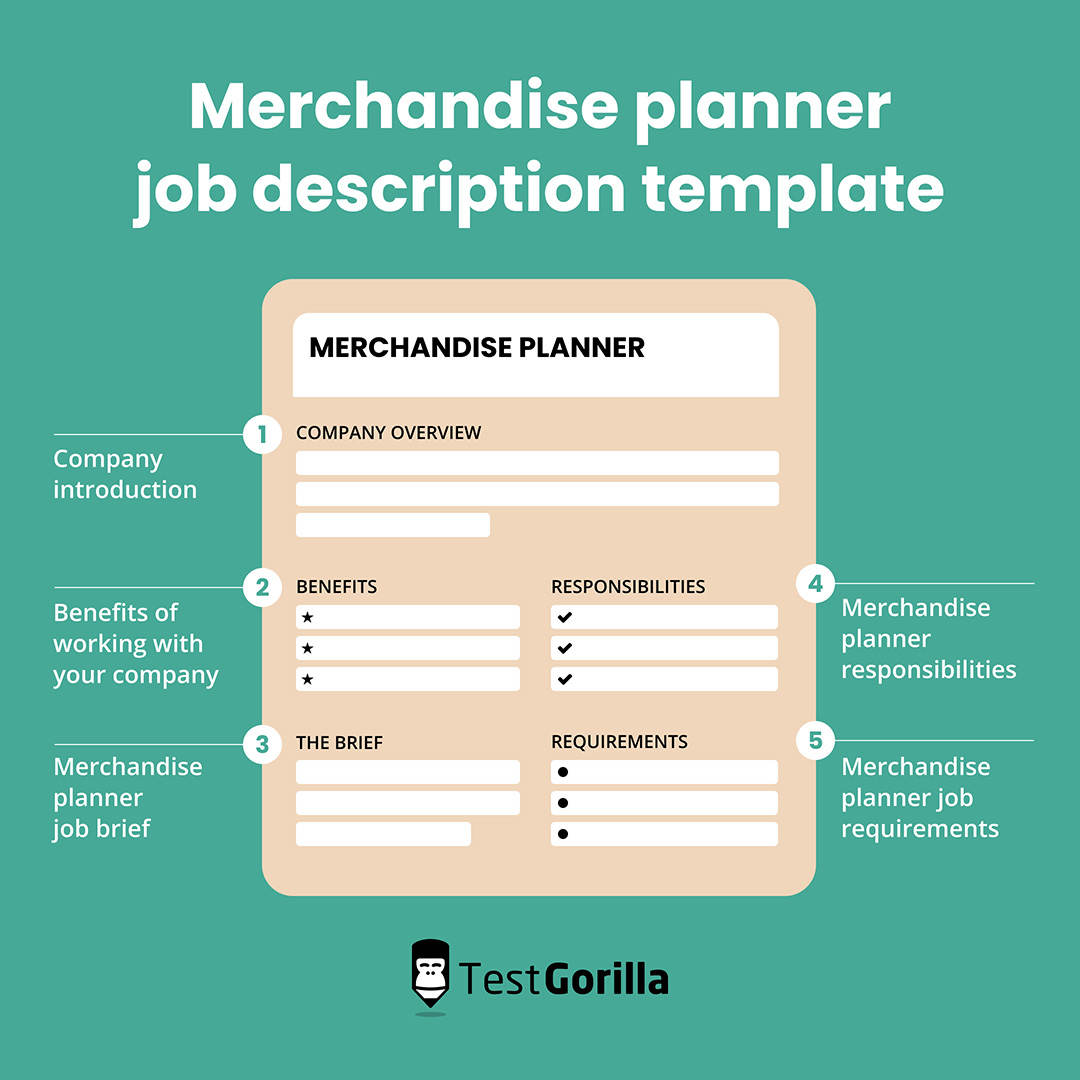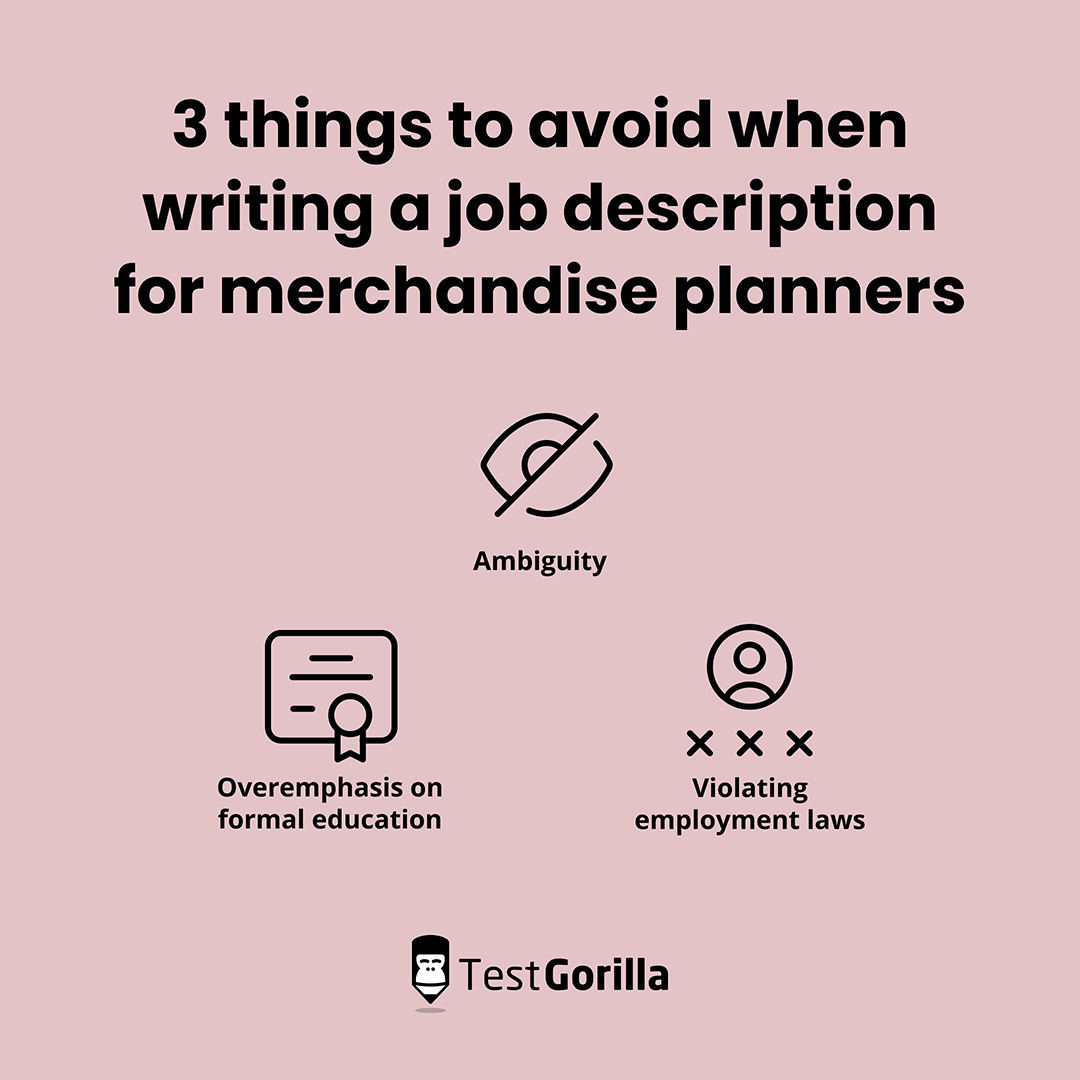Your merchandise planner job description can greatly influence the quality of applicants you attract. A sub-par description runs the risk of deterring the very people you want to hire, whereas a strong job description will attract strong applicants.
A merchandise planner can significantly impact your company's success. Hiring the wrong person can negatively impact your company’s performance long after you rectify your mis-hire.
In this article, we explore the key components to include in a merchandise planner job description. We also offer a template to help you write a job ad that attracts your ideal candidates.
Table of contents
- What is a merchandise planner?
- Key skills to look for in merchandise planners
- How to write an effective merchandise planner job description
- Merchandise planner job description template
- 3 things to avoid when writing a job description for merchandise planners
- Next steps: Attracting and assessing merchandise planner candidates
- FAQs
- Find the best merchandise planner candidates with TestGorilla
What is a merchandise planner?
Merchandise planners analyze sales data, forecast future trends, and implement inventory strategies to maximize sales and profitability. The job is typically office-based but can require visiting stores and attending trade shows. A merchandise planner’s responsibilities might involve a company’s entire inventory or focus on a single product category.
Key skills to look for in merchandise planners
Merchandise planners use a range of skills and knowledge in their day-to-day work. Their main skills include:
Analysis
Merchandise planners must be able to analyze sales data, identify patterns, and determine trends. This is essential for developing strategies to optimize sales. This requires the ability to understand complex issues and approach situations in a logical and structured manner.
Organization
Strong organizational skills are essential for many merchandise planner responsibilities, including managing inventory, dealing with different data, and collaborating with people within and outside their team. Organized merchandise planners work more efficiently, make fewer errors, and can ensure your deadlines are met.
Communication
Your merchandise planner must share information clearly and accurately to execute plans and achieve objectives. Communication skills are crucial for key tasks like presentations, negotiations, report writing, and successful teamwork.
The best insights on HR and recruitment, delivered to your inbox.
Biweekly updates. No spam. Unsubscribe any time.
How to write an effective merchandise planner job description
Follow these tips to attract top merchandise planner applicants:
Provide specific job details
Include specific job duties and detail the typical day-to-day responsibilities, even if they’re not directly related to merchandise planning – from monitoring stock levels to attending meetings. Being specific helps prospective applicants understand the role and your company. By doing this, you’ll draw in a higher percentage of suitable applicants.
Include soft skills
When hiring for a results-driven position like a merchandise planner, don’t overlook the importance of soft skills. Some candidates may have great inventory management skills but lack the mindset it takes to work with others and maintain good business relationships.
Explicitly mentioning qualities like teamwork, ability to handle conflict, and effective communication helps prospective applicants understand how important interpersonal skills are in your work environment.
Be inclusive
Practicing inclusive hiring practices gives you a wider pool of applicants to choose from and helps you stay on the right side of fair hiring laws. What’s more: by bringing in different perspectives, you can better understand your customer base. Include any steps your company takes to be inclusive and support a diverse workforce, such as adjustments for people with disabilities.
Taking a skills-based approach by emphasizing specific abilities over academics in your job description is another great way to foster inclusivity. It also helps you identify the best-suited candidates without any bias getting in the way.
Merchandise planner job description template
Here’s a template you can use to write your job description.
Company introduction
Give a brief introduction to the company and explain the role the merchandise planner you're hiring will have within it. Clarify the type or retailer you are and the kinds of products the merchandise planner will be responsible for. Summarize the company culture and the things your company and customers value.
Benefits of working with [your company]
List the incentives for working for your company. Include benefits – like a supportive work environment, store discount, and employee development opportunities.
Merchandise planner job brief
[Company name]
Job title: [Merchandise Planner (include the team or department if necessary)]
Reports to: [For example, Supervisor or Manager]
Position type: [For example, full-time, part-time, remote, or hybrid]
[Compensation details]
Merchandise planner responsibilities
Developing merchandising strategies to reach financial goals
Analyzing historical sales data and forecasting future trends
Monitoring stock to ensure optimal inventory levels
Utilizing technology to streamline processes and increase efficiency
Implementing markdown and clearance strategies
Implementing plans to optimize seasonal and holiday sales
Coordinating with buyers and other teams to ensure product availability
Allocating resources and mentoring team members
Analyzing customer feedback and making changes accordingly
Monitoring industry trends and adjusting plans as needed
Generating regular reports
Preparing and delivering presentations
Merchandise planner job requirements
Bachelor’s degree in merchandising, business, marketing, or a related field (or equivalent experience)
Ability to work independently and as part of a team
[Number+] years’ experience in merchandise planning or a product management role
Excel and Microsoft Office Suite proficiency
Attention to detail
Excellent organizational skills
Strong written and verbal communication
An analytical mindset
3 things to avoid when writing a job description for merchandise planners
Here are some common pitfalls you should avoid in your job description:
Ambiguity
Unclear job descriptions can increase unsuitable applications and deter the applicants you want. For example, a description that says “inventory management of our stores” but doesn’t detail the number of stores leaves candidates in the dark about the scope of the role.
Avoid ambiguity by being clear about the role, its responsibilities, and your requirements.
Overemphasis on formal education
While educational qualifications are important, don't overemphasize them. Centering job requirements around education can deter great candidates without formal qualifications. In merchandise planning, expertise – like a profound understanding of market dynamics – comes from hands-on experience. Some of your best candidates might have significant experience but lack a traditional academic background.
So, focus on the qualities and practical expertise that candidates need for the role.
Violating employment laws
Your job description is subject to federal laws, including the Civil Rights Act. This prohibits employment discrimination based on factors like including race, sex, religion, and national origin. Depending on what state and city you’re in, your hiring practices might also be subject to ban-the-box legislation.
Ensure the wording in your merchandise planner job description doesn’t discriminate. For example, gendered language and phrases like “fashion queen” can show bias toward female applicants and discriminate against other genders.
Next steps: Attracting and assessing merchandise planner candidates
The next two steps are just as important as writing your job description:
1. Publish your job description
Post your job ad on your website and online job boards so it’s visible to merchandise planners who are actively seeking employment.
2. Review applications
When you’ve got a pool of applicants, you need a good way to evaluate them.
r example, you might use TestGorilla’s Merchandise Planner test, which assesses candidates across a variety of role-specific skills – including preparing seasonal plans and identifying risks and opportunities. You can combine this with other tests to get a full view of each candidate.
TestGorilla offers a curated selection of tests for merchandise planners, including:
Culture add
Communication
Negotiation
Problem-solving
TestGorilla’s software provides results that give you a clear and easy-to-understand evaluation of each candidate. So, there’s no need to spend time and resources manually reviewing completed assessments.
FAQs
Should I include the salary in a merchandise planner job description?
In some states, including the salary range in job ads is a legal requirement. Even in states that don’t mandate this, providing salary and benefits info can be advantageous. It increases transparency and helps ensure that the candidates who apply will be happy with your compensation package. What’s more: including competitive compensation helps you sell your role more effectively than your competitors.
Should I require a degree in my job description?
While it's common to see a degree as a requirement in merchandise planner job descriptions, a candidate doesn’t need a degree to excel in the role.
Adopting a skills-based hiring approach can provide a clearer insight into candidates’ true capabilities. This ensures you don't overlook candidates with expertise acquired through hands-on experience.
Find the best merchandise planner candidates with TestGorilla
The time you invest in crafting a strong merchandise planner job description will result in stronger applicants. By outlining clear expectations and emphasizing key skills, you’ll stand a much better chance of appealing to people who match your requirements.
TestGorilla provides an efficient and reliable way to identify your strongest candidates by focusing on their skills and traits.
This approach minimizes the risk of making a mis-hire that could negatively impact your company. Take a product tour to see how TestGorilla can help you find the ideal merchandise planner for your team.
You've scrolled this far
Why not try TestGorilla for free, and see what happens when you put skills first.
















